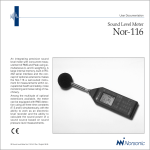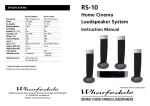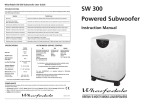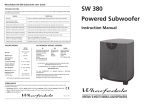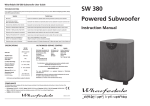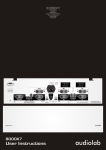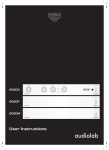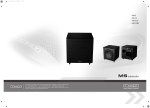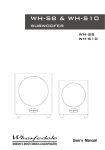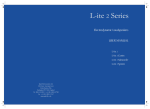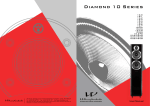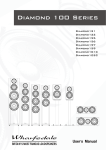Download Wharfedale SUBWOOFER RS-10 User's Manual
Transcript
RS-10 SUBWOOFER USER INSTRUCTIONS CARE AND MAINTENANCE If you play the speakers with the grilles off exercise great care. NEVER touch the drive units which are easily damaged. The loudspeaker cabinets can be cleaned with a damp cloth or with a spray furniture polish and a soft cloth. Apply the spray sparingly to the cloth and then polish the cabinet. Never apply spray directly to the cabinet. GUARANTEE & SERVICE In the unlikely even that your unit develops a fault you should return it to your Wharfedale dealer using the original packing to ensure safe shipping. The terms of your guarantee may vary in different countries but in all cases the guarantee excludes: All damage caused through accident, misuse, wear and tear, neglect, incorrect installation, adjustment or repair by unauthorised personnel. Liability for damage or loss occurring in transit to or from the purchaser. Wharfedale will not be liable for any consequential damage, loss or injury, arising from or in conjunction with this equipment. AUTHORISED SERVICE CENTRES UK USA CANADA IAG Service Centre Unit 4,. St Margaret’s Way Stukeley Meadows Industrial Estate Huntingdon Cambs PE29 6EB England IAG America, Inc. 15 Walpole Park South Walpole MA 02081 Korbon Trading Ltd 6800 Kitimat Road Units 19-20 Mississauga Ontario Tel: +1 905 567 1920 RS-10 Subwoofer Instruction Manual For information on other authorised service centres worldwide contact Wharfedale International in the U.K. A worldwide distributor list is available on the Wharfedale website: www.wharfedale.co.uk The name ‘WHARFEDALE' is a registered trademark of Wharfedale International Ltd. Wharfedale has a policy of continuous product development and reserves the right to change specification without notice. Wharfedale is a member of the International Audio Group. COMPLIANCE This Wharfedale product complies with the relevant clauses enshrined in the following standards and directives in force at the time of the introduction of the product. ! EU Directives: 89/336/EC, 72/23/EEC: Safety: EN60065 (CB Scheme): Emissions: EN55013, EN61000 Immunity: EN55020:2002. ! USA: UL 6500:2002. Approved under the verification provision of FCC Part 15 as a Class B Digital Device. ! CANADA: CAN/CSA-E60065-00 Wharfedale International Ltd, IAG House, Sovereign Court, Ermine Business Park, Huntingdon, Cambs PE29 6XU, England. BRITAIN'S MOST FAMOUS LOUDSPEAKERS RS-10 SUBWOOFER USER INSTRUCTIONS IMPORTANT SAFETY INFORMATION Read these instructions. Keep these instructions. Heed all warnings. Follow all instructions. Do not use this apparatus near water. Clean only with dry cloth. Do not block any ventilation openings. Install in accordance with the manufacturer's instructions. Do not install near any heat sources such as radiators, heat registers, stoves, or other apparatus (including amplifiers) that produce heat. RS-10 SUBWOOFER USER INSTRUCTIONS harmful interference to radio communications. However, there is no guarantee that interference will not occur in a particular installation. If this equipment does cause harmful interference to radio or television reception, which can be determined by turning the equipment off and on, the user is encouraged to try to correct the interference by one or more of the following measures: ! ! ! ! Do not defeat the safety purpose of the polarized or grounding type plug. A polarized plug has two blades with one wider than the other. A grounding type plug has two blades and a third grounding prong. The wider blade or the third prong are provided for your safety. If the provided plug does not fit into your outlet, consult an electrician for replacement of the obsolete outlet. Use only with a cart, stand, tripod, bracket, or table specified by the manufacturer, or sold with the apparatus. When a cart is used, use caution when moving the cart/ apparatus combination to avoid injury from tip-over. Warning: To reduce the risk of fire or electrical shock, do not expose this product to rain or moisture. The product must not be exposed to dripping and splashing and no object filled with liquids such as a vase of flowers should be placed on the product. No naked flame sources such as candles should be placed on the product. Caution: Changes or modifications not expressly approved by the manufacturer could void the user's authority to operate this device. Warning: The mains power switch for this appliance is located on the rear panel. To permit free access to this switch, the apparatus must be located in an open area without any obstructions. NOTE: This equipment has been tested and found to comply with the limits for a Class B digital device, pursuant to part 15 of the FCC Rules. These limits are designed to provide reasonable protection against harmful interference in a residential installation. This equipment generates, uses and can radiate radio frequency energy and, if not installed and used in accordance with the instructions, may cause Possible Cause Sound lacks bass content Bass reproduction indistinct Front loudspeakers out of phase. Subwoofer not switched on; Subwoofer phase incorrect; Subwoofer crossover control too low Excessive bass distortion at low volumes Subwoofer level set too high; LFE level set too high; Subwoofer incorrectly wired CAUTION! Excessive or distorted bass at high levels System level set too high; Bass control set too high; Speakers too close to room corners RISK OF ELECTRIC SHOCK DO NOT OPEN Distorted or rattling sounds at high levels System level too high; Objects on speakers/subwoofer; Objects too close to subwoofer SW 250 will not respond to commands Handset batteries weak; handset too far away; line of sight is impeded Popping or thumping from the subwoofer System level set high; Subwoofer level set too high; LFE level set too high Indistinct sound; Poor localisation of effects. Poor localisation of dialogue One or more loudspeakers is out of phase (Read the manual for correct connection procedure) Television picture colour is distorted Subwoofer too close to TV. (Switch off system and TV. Move units away. Leave 15 mins. Switch on) This symbol indicates that there are important operating and maintenance instructions in the literature accompanying this unit. Unplug this apparatus during lightning storms or when unused for long periods of time. Symptom System not switched on; Speaker cables shorting terminals out; Wrong source selected ADVERTISSEMENT: RISQUE DE CHOC ELECTRIQUENE PAS OUVRIR Use only attachments/accessories specified by the manufacturer. If your system is not working properly please work through this checklist before returning a unit to your dealer. Before investigating a problem, always switch off the system at the mains. No Sound TO REDUCE THE RISK OF ELECTRIC SHOCK DO NOT REMOVE COVER (OR BACK) NO USER-REMOVEABLE PARTS INSIDE REFER SERVICING TO QUALIFIED PERSONNEL Protect the power cord from being walked on or pinched, particularly at plugs, convenience receptacles, and the point where they exit from the apparatus. Refer all servicing to qualified service personnel. Servicing is required when the apparatus has been damaged in any way, such as powersupply cord or plug is damaged, liquid has been spilled or objects have fallen into the apparatus, the apparatus has been exposed to rain or moisture, does not operate normally, or has been dropped. Reorient or relocate the receiving antenna. Increase the separation between the equipment and receiver. Connect the equipment into an outlet on a circuit different from that to which the receiver is connected. Consult the dealer or an experienced radio/TV technician for help. TROUBLESHOOTING This symbol indicates that dangerous voltage constituting a risk of electric shock is present within this unit. ESSENTIAL INFORMATION FOR UK USERS The power cord on your subwoofer may be supplied with a plug incorporating a fuse, the value of which is indicated on the pin face of the plug. Should the fuse need to be replaced, an ASTA or BSI approved BS1362 fuse must be used of the same rating. If the plug is cut off it must NOT be re-used. Dispose of any such plug safely. There is a danger of electric shock if a cut-off plug is inserted into a mains socket. The wires in the mains lead are coloured in accordance with the following code: Green and Yellow - Earth: Blue - Neutral: Brown - Live. As the colours of the wires in the mains lead may not correspond with the markings identifying the terminals in the replacement mains plug, proceed as follows: The wire coloured Blue must be connected to the terminal marked with EARTH the letter ‘N’ or coloured Black. The wire (GREEN/YELLOW) coloured Brown must be connected to the terminal marked with the letter ‘L’ or FUSE coloured Red. The wire coloured Green and Yellow must be connected to the terminal marked with the letter ‘E’,or coloured Green, or Green and Yellow, or NEUTRAL LIVE marked with the Earth symbol (BLUE) (BROWN) SPECIFICATIONS Model Format Drive Unit Amplifier Power Line Input Sensitivity Averaged Max. O/P (@ 1M) Frequency Response (Boundary Position) Low Pass Filter Frequencies Phase Adjustment Dimensions (H x W x D) mm Height on Feet mm RS-10 .SUBWOOFER Powered Subwoofer 250 mm kevlar cone 250W 250mV for 200W 107 dB 30 Hz – 95Hz 35 Hz – 85 Hz (6 x 10Hz steps) Switchable 0º - 180º 370 x 546 x 295 400 of the Volume Control on your amplifier is NOT a reliable guide as to ‘how loud’ your equipment will play. Allow your system ample ‘headroom’. GENERAL GUIDANCE DO NOT connect the mains power to any signal input terminal. DO NOT change any connections without first switching off the power to all the components in your AV system. ALWAYS turn down the system master volume control before turning the equipment on or off. DO NOT use your amplifier at its maximum volume setting. The resulting distortion may damage your loudspeakers and subwoofer. The position Do not operate your subwoofer closer than 450mm from the TV to avoid distorting the colour picture. if this occurs, switch the TV set off. After 15 minutes switch on again: colour balance should now be restored. To minimise hum and mains interference ensure that low level (line level) signal cables are well screened. Avoid routing low-level signal cables close to or parallel with mains power wiring. Page 2 Page 7 RS-10 SUBWOOFER USER INSTRUCTIONS The subwoofer has to blend with the main speakers: if you place the subwoofer where it amplifies the irregularities of the room or the main speakers the result will be bloated, coloured bass. If acoustic guitar and male voice sounds coloured when the subwoofer is operating and less coloured when in standby, you need to address the positioning first before adjusting any controls The optimal position for the subwoofer is 50mm from a rear wall, i.e. with the amplifier heatsink 10mm from the wall. On no account should the heatsink touch the wall. Loudspeaker Phasing It is absolutely essential for all speakers to be connected correctly with the RED + and BLACK - terminals of the speakers connected to the corresponding RED + and BLACK - terminals of the AV amplifier (‘in phase’). This is particularly important if speakers are bi-wired. If the sound is not as clear as it could be, check all speaker connections carefully before proceeding further. Correctly connected front channel loudspeakers give a definite centre sound source with full bodied tenor and bass registers.In Stereo, if there is a doubt about the way the loudspeakers are connected, check their phasing by playing a mono source - the sound should appear from a point midway between the two loudspeakers. If this position is indefinite, reverse the connections to one of the loudspeakers. Correctly connected loudspeakers give a definite centre sound source with fuller bodied tenor and bass registers. Setting the Phase of the Subwoofer Phase at very low frequencies is not straightforward to detect. Initially we suggest you temporarily set the low pass filter to ‘off’ and the phase to 0º and play some bass heavy music in Stereo through the main speakers and the subwoofer. From the listening position, switch the phase between 0º and 180º. The setting which appears to give the greater bass output is correct. Now follow the instructions below for setting the low pass filter. Home Cinema Systems Low Pass Filter If you are using a digital AV processor the initial setting should be ‘OFF’ as the processor will have its own bass management system. Most digital AV Processors ask you to specify the size of speakers in the various channels. These are usually ‘Large’ or ‘Small’. This sets the bass management for the system. Unless your loudspeakers are large floor standing units, you should choose 'Small' for the Front channels, as the subwoofer is going to be better at providing clean, deep bass. Choose 'Small' for the surround channels and also for the Centre channel, so that any bass from these channels will be directed to the subwoofer. Set the ‘Subwoofer’ option on the processor to 'On’ or 'Yes'. After experimenting with various sources you may need to adjust the LPF settings. The goal is to ensure the subwoofer blends seamlessly into the sound stage. Setting the subwoofer to Standby should reduce the bass extension, not change the bass level - as always personal taste plays an important part. Setting levels Once the loudspeaker settings have been finalised, put the AV amplifier into its “Test” mode (see instructions supplied with your processor.) Adjust the levels until all channels are reproduced at equal loudness. When adjusting the subwoofer output level avoid setting too high a level or you will swamp the sound with bass which be tiring to listen to and RS-10 SUBWOOFER USER INSTRUCTIONS may limit the subwoofer’s ability to respond to large bass transients. Set a sensible level going into the subwoofer from the processor. The volume display should be around 50 at normal listening levels. LFE This channel was originally an additional bass channel with its own dedicated subwoofer. In practice however, if any speakers are set to ‘Small’, the LFE channel is combined with the bass from those channels and fed into the subwoofer. When you set the LFE level from your AV processor, use care as the LFE channel contains powerful low frequencies which, although normal in a cinema, may overload a domestic subwoofer. If, during a programme, you hear popping or thumping noises from the subwoofer, turn the AV Processor volume level down and back off the LFE level. If this does not cure the problem, lower the subwoofer volume level. Note: If any channels are set to ‘Small’ the subwoofer must be on when the system is playing otherwise there will be reduced bass , and no LFE. PRELIMINARIES REAR PANEL CONNECTIONS Open the carton and remove all the top packing pieces. Lift the subwoofer out taking care not to damage the cabinet. When lifting the unit from the carton support it from the bottom. DO NOT attempt to lift the subwoofer out of the carton using the polythene bag. The unit is heavy; if you cannot manage it easily, get someone to assist you. The amplifier heatsink must be 10mm away from the wall After removing the subwoofer from the carton, remove the plastic bag. Retain the packing materials for future use or return them to your dealer. If you decide not to keep the packing, please dispose of it having regard to any recycling regulations in your area. Please retain the user manual and the purchase receipt for future reference. If you transfer this equipment to a third party, please ensure all the instructions are passed on with the product. INPUT RS 10 SUBWOOFER OUTPUT WHARFEDALE INTERNA TIONAL LTD,HUNTINGDON, UNITED KINGDOM LEFT RIGHT LINE LEVEL CHANGING THE SUBWOOFER FEET CAUTION RISK OF ELECTRIC SHOCK DO NOT OPEN Fitting Spikes Subwoofer Settings for RS-10 loudspeakers. ! ! Set all channels to ‘small’ If you are using a digital AV processor the subwoofer LPF setting should be 85Hz. Low Pass Filter: The low pass filter should be set having regard to the size and low frequency extension of the main speakers. The role of the subwoofer is to extend the bass response of the system not to increase the overall bass level. If the loudspeakers are large the LPF should be set low, a value around 45-55 Hz is a good place to start. With smaller speakers this can be increased, up to 85Hz for very small bookshelf units. As always the final value is determined by listening. Low-level Listening Our ears are far more sensitive to midrange frequencies (2-5 kHz) than bass frequencies. Very low bass and especially percussive bass is ‘felt’ rather than heard. At low sound levels bass frequencies appear to attenuate faster than midrange and treble. As the level increases this bass roll-off decreases. Occasionally we may wish to listen to a normally loud piece of music at a low level but with retention of the bass information. There may be a case for assigning a preset for low level listening where the subwoofer volume is set somewhat higher and the LPF is set a little lower - as always this is for individual judgement. Testing the system The simplest way to test the system is to play, at a moderate level, music with deep consistent bass. Switching the subwoofer in and out of Standby should cause change of the depth of bass, and the ambience will also alter. If there is a significant change in bass volume, or a noticeable step in the bass response, or an increase in coloration when the subwoofer is playing, the setup needs to be refined further. By entering different settings in different presets, you will be able readily to identify the most favourable combination. ON OFF Invert the subwoofer. Protect the top by placing it on a soft surface such as a towel. Loosen each threaded washer and unscrew the rubber feet. N2082 POWER AC 220-240V~50Hz 400W FUSE T4AL250V SPEAKER LEVEL INPUTS Mains Input Speaker (High) Level Inputs Mains Fuse Line Level Outputs Mains Power Switch Line Level Inputs Washer CONNECTING THE SUBWOOFER Power Connections Before connecting your subwoofer check that the check that mains voltage marked on the amplifier panel is correct for your mains supply. Spike Note: When using spiked feet take care not to drag the subwoofer and be careful not to pierce objects or cables which may be hidden under carpets, etc. Spikes are not suitable for use with stone floors and can cause damage to wood floors, so consider carefully before using them LEVELLING THE SUBWOOFER Screw each foot in and out until the subwoofer is level (side to side and front to back) and firmly supported Tighten the washers on the feet with a wrench to lock them in position. ! 230 volt products - 220 volts to 240 volts ! 115 volt products - 110 volts to 120 volts Connecting to a Digital AV processor If your AV processor has a line level or LFE subwoofer output you should use this connection. You will need to purchase a single screened RCA phono lead from your dealer. Connect this lead to the Left line input of the Subwoofer as shown below. INPUT OUTPUT SUBWOOFER OUTPUT AV PROCESSOR LEFT RIGHT LINE LEVEL SUBWOOFER INSTALLATION Stereo Line Level Connections Positioning the subwoofer Stereo line level connections will be necessary where there is no dedicated single subwoofer output, but where there is either : The RS-10 subwoofer uses a rear-firing bass driver. For the unit to perform at its best it should be placed with the heatsink fins 10 mm away from a wall. The bass driver will now be 50mm from the wall. The rear wall should be smooth, solid and free from vibration. The floor under the subwoofer should be firm and free from rattles. Caution: Do not place the subwoofer touching the wall. There must be air circulation around the unit and the mains switch should be accessible at all times. ! ! A stereo subwoofer line output or a separate preamp output. In stereo systems where there is a suitable preamplifier line output, or if an integrated amplifier, a pre/main link that can be separated. The output must be controlled by the system volume control - a tape output is not suitable. If you are in doubt, consult your dealer. Stereo Connections: Connect a stereo RCA phono cable from the line output of the preamp to the Subwoofer line inputs. Although the unit may be sited by either the rear or side walls, we recommend that is placed in front of the listener central to the listening position. To avoid excessive booming and coloration we suggest that you operate the subwoofer at least 500mm away from corners. There should be a line of sight between the listener and the front of the subwoofer otherwise the remote functions will not be operable. Page 6 RIGHT LEFT SERIAL No: Remove the threaded washers and replace them on the spikes. Screw a spike part-way into each hole and hand-tighten the washer. When all four feet have been fitted, stand the subwoofer upright. After experimenting with various sources you may need to adjust the LPF. If you choose too low a setting there will be a ‘hole’ in the bass response. Choose too high a frequency and the bass will appear bloated with loss of definition. The optimal setting for RS-10 speakers is 85Hz. Stereo Reproduction ! The subwoofer is fitted with rubber feet. A set of spikes is also provided. Page 3 INPUT OUTPUT LEFT Preamp Output AV PROCESSOR/STEREO PREAMP RIGHT LINE LEVEL SUBWOOFER RS-10 SUBWOOFER USER INSTRUCTIONS Pre Out - Main In Connections If you use a separate stereo pre and power amplifier, or an amplifier where the pre and main amplifier can be separated, connect the subwoofer as shown. There are two alternative methods. A: You will need two screened RCA ‘Y’ adaptors and two single RCA phono cables. Remove the Pre-Main links on your amplifier. Connect the socket (common) of an RCA ‘Y’ adaptor to one of the mono cables. Connect one leg of the ‘Y’ adaptor to the Left Channel Pre Out socket on the amplifier and the other leg to the Left Channel Main In socket. Connect the remaining plug on this combination to the Left Channel Line Level Input on the subwoofer. Repeat this for the Right Channel. RS-10 SUBWOOFER USER INSTRUCTIONS There are two methods of connecting the subwoofer: OPERATING YOUR SUBWOOFER A: Ensure the Front loudspeakers are correctly connected. Remote Handset Using one of the additional twin core cables, connect the Left Speaker Terminals on the sub bass unit to the Front Left speaker terminals on the amplifier. Connect the Red (+) speaker terminal on the amplifier to the Red (+) terminal on the subwoofer. Connect the Black (-) speaker terminal on the amplifier to the Black (-) terminal on the subwoofer. Now connect the Right Speaker terminals on the subwoofer to the Front Right speaker terminals on the amplifier. All control functions are carried out using the remote handset. AMPLIFIER (x2) MAIN PRE IN OUT L R Installing batteries The handset operates on two LR6 (AA) batteries which are supplied The battery compartment is located at the rear of the handset. Unwrap the batteries and slide the cover off the handset. Place the batteries in the handset, the correct orientation is shown on the diagram. When the batteries are installed, replace the cover. SUBWOOFER CONTROL FRONT RIGHT Volume: Press the Volume + key to increase the volume level. Press the Volume - key to decrease the volume level of the subwoofer. The volume range on the front panel display varies from 00 (minimum) to 99 (maximum). OUTPUT RIGHT LEFT LEFT AA RIGHT AA To change from one preset to another, press a preset key on the remote for less than 3 seconds to recall the settings of that preset. The display will show the preset number: LINE LEVEL SUBWOOFER FRONT RIGHT LEFT FRONT LEFT RIGHT SPEAKER LEVEL INPUTS Connect a Stereo cable from the Line Level Inputs of the subwoofer to the Pre Out sockets of the amplifier. Now connect a second Stereo cable from the Line Level Outputs of the sub-woofer to the Main In sockets of the amplifier. Make sure that the Right and Left Channels are not mixed up! The sub-woofer is now inserted within the system loop. Switching on the Subwoofer L PRE OUT Check that all the connections to the subwoofer have been properly made and that the system volume control is at minimum. Plug the supplied power cord into the mains socket on the rear panel. Plug the mains plug into the wall socket and switch the power on. Now switch the subwoofer on with the rest of your system. The subwoofer on/off switch has a rocker action; press the upper part to switch the equipment on and the lower part to switch it off. When switched on the light above the power switch will glow and the subwoofer will be operational. B: Alternatively you may connect the subwoofer to the Front speakers. AMPLIFIER MAIN IN FRONT INPUT RIGHT AMPLIFIER LEFT OUTPUT R LEFT RIGHT LEFT RIGHT LINE LEVEL SUBWOOFER LEFT RIGHT SPEAKER LEVEL INPUTS Speaker Level Connections The high level Speaker connections should be used only if your amplifier does not have a line level subwoofer output. In this connection the subwoofer is fed together with the Front loudspeakers. For this you will need two extra twin core cables. Choose a good quality audio speaker cable of reasonable gauge. Avoid using cheap ‘bell’ or ‘zip’ cables. Audio speaker cable has a polarity stripe or rib along one conductor to simplify connecting your speakers. Operation - Controls and Functions SUBWOOFER FRONT LEFT FRONT RIGHT If your speakers are bi-wired: You should ensure that you connect the subwoofer to the BASS terminals ONLY. AMPLIFIER Control functions are carried out using the remote handset. To operate, the handset must be point at the subwoofer and be in direct line of sight. LOW PASS FILTER SELECT RIGHT 35Hz LEFT 45Hz 55Hz 65Hz 75Hz OFF 85Hz MEMORY VOL UME PHA SE 0 2 1 3 LEFT 4 RIGHT SPEAKER LEVEL INPUTS SUBWOOFER FRONT RIGHT FRONT LEFT When routing any cables to loudspeakers do not run them across open floor spaces where they may cause danger to people and pets. Route them safely, around room boundaries if necessary. Page 4 SETTING UP YOUR SUBWOOFER General Notes Your subwoofer is most likely to be used with two typical programme sources, music and movies. The setup for these two very different sources may be different if best results are to be achieved. Please read these setup notes in conjunction with your processor and speaker manuals. All setting up of the subwoofer should be performed with tone controls and filters set ‘flat’. Listening Rooms and Subwoofer Positioning: To help locate standing waves in your listening room, one idea is to sit in the listening seat and recruit a friend with a deep voice to speak as he moves around the area where you propose to site your subwoofer - you will soon find out where not to site it! Where the voice sounds most natural is a good place to start. 180 POWER Note: When brought out of standby for the first time, the unit will display the factory presets. Thereafter, bringing the unit out of standby will revert it to the operational state last used. If you switch the power on and off at the rear panel while the unit is in standby, the unit will power up to a normal operating state (i.e. not in standby). To enter standby, again press the Standby key. Listening rooms are not ideal. Most rooms are reverberant with some parallel walls. Because of room geometry and construction there will be areas with severe peaks at some frequencies and severe troughs at others. These peaks and troughs are called ‘standing waves’ and if you site loudspeakers in such areas the response will be highly non-linear. With subwoofers this situation is exacerbated by the fact that it is easier to treat high frequency irregularities by the use of drapes, soft furnishings etc., but very hard to do the same at bass frequencies due to the very long wavelengths - at 40 Hz the wavelength is almost 9 metres! Standby: The Standby key brings the subwoofer in and out of Standby. The drawing below shows a typical front panel display during operation. FRONT Split the cable at each end to a depth of 25mm. Strip about 7mm of insulation from each end and lightly twist to gather the wire strands. The Speaker Level connectors are screw terminals located on the control panel. Unscrew a terminal and insert the cable into the hole at the base. Retighten the terminal securely. Make sure that the terminal grips the bare wire and there are no loose strands which could touch adjacent terminals. If you select a preset and then alter any aspect of the setup, the preset light will extinguish (as the setup no longer matches the preset). SUBWOOFER B: You will need two stereo (or four single) screened RCA cables. Phase: This key toggles the subwoofer between 0º and 180º phase shift. Presets: Four different settings of level, frequency and phase can be stored. Pressing and holding any of the preset keys on the remote for 3 seconds will cause the current settings to be stored in that preset. The display will show the preset number then flash the preset number once to show it has stored the preset. LEFT INPUT AMPLIFIER Low Pass Filters: Pressing the appropriate filter key will select the frequency at which the subwoofer rolls off. The filter has steps at Off and 35Hz-85Hz in 10 Hz increments. When ‘OFF’ is selected the subwoofer operates over its full designed range. Pressing other keys lowers the maximum operating frequency. The Low Pass Filter value should be chosen having regard to the nature of the Front speakers and programme material. Follow the Setup Notes on Page 6 and the instruction manual of your AV processor (if used) for more guidance. The preset light will not light if no preset has been set up or if a preset has been over-ridden. In Standby mode all the lights on the subwoofer front panel are extinguished. The rear panel light remains on to show the unit is powered. The low frequency response of the subwoofer and its blend with the main loudspeakers is greatly affected by positioning. Although bass is enhanced by walls or corners, so often is coloration. As the drive unit faces rearward, the wall will influence the sound. The wall should be smooth and solid and ideally, nonr-everberant. The surface under the subwoofer should be stable and unobstructed. I Page 5





